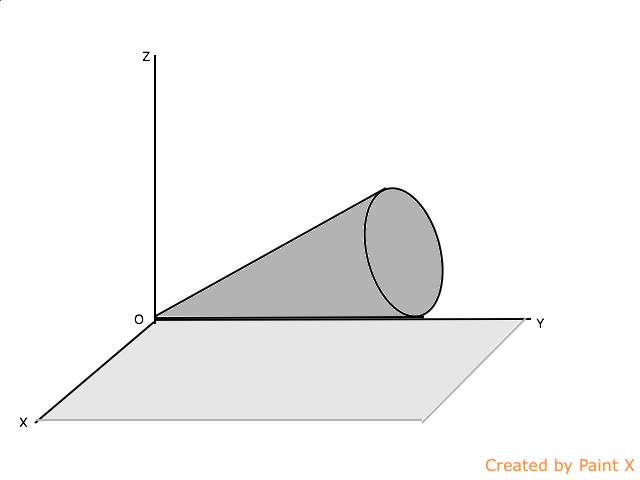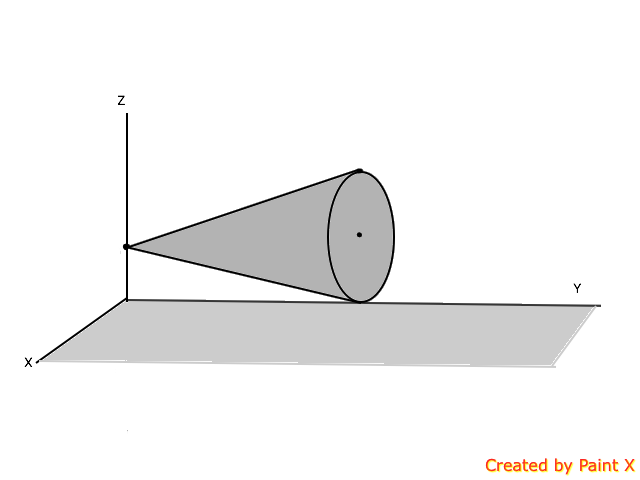Complex motion part 2
1.A solid cone of length and half angle is rolling on a plane about its vortex with an angular velocity of , as shown in Fig. Compute the angular velocity, angular momentum, and kinetic energy of the cone.
 2.
2.
 The vertex of the aforementioned cone is fixed on the axis at a height equal to the radius of the cone. The cone rotates an angular velocity of
about the vertical axis as shown in Fig. Compute the angular velocity, angular momentum, and kinetic energy of the cone.
The vertex of the aforementioned cone is fixed on the axis at a height equal to the radius of the cone. The cone rotates an angular velocity of
about the vertical axis as shown in Fig. Compute the angular velocity, angular momentum, and kinetic energy of the cone.
No vote yet
1 vote
Easy Math Editor
This discussion board is a place to discuss our Daily Challenges and the math and science related to those challenges. Explanations are more than just a solution — they should explain the steps and thinking strategies that you used to obtain the solution. Comments should further the discussion of math and science.
When posting on Brilliant:
*italics*or_italics_**bold**or__bold__paragraph 1
paragraph 2
[example link](https://brilliant.org)> This is a quote# I indented these lines # 4 spaces, and now they show # up as a code block. print "hello world"\(...\)or\[...\]to ensure proper formatting.2 \times 32^{34}a_{i-1}\frac{2}{3}\sqrt{2}\sum_{i=1}^3\sin \theta\boxed{123}Comments
Here is my attempt at the second one. There are two rotations to consider:
1) The rotation of the cone about its own axis
2) The rotation of the cone about the vertical axis
Let H be the height of the cone, R be the radius of the cone, and α be the semi-angle.
tanα=HRH=tanαR
Let the angular speed of the cone with respect to the vertical axis be ω, and the angular speed of the cone with respect to its own axis be ω′. They are related as follows (assuming no slipping):
Hω=Rω′
Let I and I′ be the moments of inertia with respect to the vertical axis and the cone axis, respectively.
I=203M(R2+4H2)I′=103MR2
The kinetic energy is then (angular momentum is similar):
E=21Iω2+21I′ω′2403M(R2+4H2)ω2+203MR2ω′2=403MR2(1+tan2α4)ω2+203MR2tan2α1ω2=403MR2ω2+209MR2tan2α1ω2
Log in to reply
Thx @Steven Chase sir got.it.(How to.solve first one any ideas ? As such axis of rotation would.be at an angle.from angular.momentum vector right )??
Log in to reply
I'll start thinking about the first one. Did I get the second one right?
Log in to reply
Yes u r right @Steven Chase Sir ( David morin has the first part of the problem in it , but I dont know how they approach the question) . ( they confused me by adding angular momentums )
Log in to reply
Can you post the energy expression for the first part, so I can check my answer when I have it?
@Steven Chase sir pls share how ur way of solving these 2 problem ? @Aaghaz Mahajan bro pls help u also ?
Log in to reply
Do you know the answers? I think the second one should be fairly easy. The first one will take a bit more work.
Log in to reply
@Steven Chase sir, Can u solve for second part and later first part sir? (Yes I know answers for second part .)
Log in to reply
Ok, I'll do the second part for now